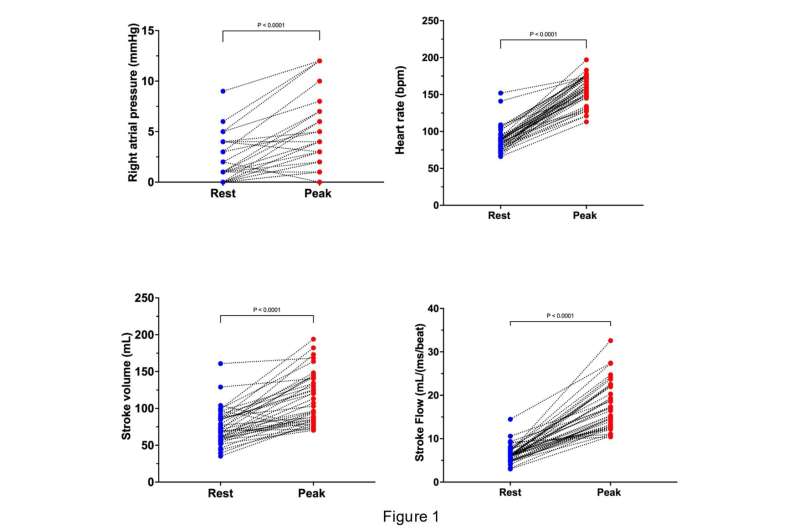This article has been reviewed according to Science X's editorial process and policies. Editors have highlighted the following attributes while ensuring the content's credibility:
fact-checked
trusted source
proofread
Study helps explain post-COVID exercise intolerance

Exercise intolerance, or the inability to perform physical activity at the expected or desired level, is one of the many symptoms associated with long COVID. In a study, Yale researchers help explain what is explicitly driving this symptom, offering much-needed information for patients and generating new directions for future research.
The study was published Dec. 15 in the journal ERJ Open Research.
When a patient reports shortness of breath or exercise intolerance, physicians will usually run tests—such as CT scans, echocardiograms, or pulmonary function testing—to determine whether the symptom is being caused by limitations in the lungs or the heart since, typically, it's one or the other. In some cases, however, neither lung nor heart function appears to be hindered.
Evidence has emerged that patients with long-term COVID-19 who experience these symptoms tend to fall in the latter category, with standard tests identifying no heart or lung limitations.
For these patients, the next step is typically a cardiopulmonary exercise test in which the patient rides a stationary bike or runs on a treadmill while sensors track physiological activity up to the point the person feels they have to stop the exercise. However, there are still patients for whom this type of test reveals no cause of exercise intolerance.
Yale is one of very few places in the United States where a more advanced version of this evaluation—the invasive cardiopulmonary exercise test, or iCPET—is available. For the test, pressure-sensing catheters are inserted into the pulmonary artery, a main blood vessel in the lungs, and at an artery in the wrist. As patients exercise, physicians track various measures to observe how well the heart, lungs, blood vessels, and muscles are functioning.
In the new study, 55 patients were evaluated for post-COVID exercise intolerance, including 41 who showed no evidence of heart or lung limitations after initial tests. They then underwent iCPET.
"We found that despite the fact that the heart was pumping oxygenated blood that the lungs were providing adequate amounts of oxygen for, the extraction of oxygen by the body's tissues was compromised in patients who had symptoms of exercise intolerance after COVID," said Peter Kahn, a pulmonary and critical care fellow at Yale School of Medicine and lead author of the study.
The study, which follows an earlier study from the research group that yielded molecular insights into the origins of exercise intolerance, also offers patients insight into their symptoms.
"The majority of patients just want to know that there's something real going on," said Phillip Joseph, assistant professor of internal medicine at Yale School of Medicine and a co-author of the study. "I think that's a very valid reason to undergo a test."
Based on his experience, Joseph believes that just having this information is enough for many long COVID patients; most, he said, do not choose to pursue the few treatment options currently available for exercise intolerance. To date, those options include high-dose vitamins and pyridostigmine, a medication for muscle weakness, both of which are approved for other uses but have not yet been tested in clinical trials for post-COVID exercise intolerance.
Another benefit of this research, said Kahn, is dispelling potentially harmful myths that have emerged around post-COVID exercise intolerance. Some patients have been told that their symptoms are a result of deconditioning or decline from lack of physical activity and that reconditioning alone would address the intolerance.
"Our findings contradict that hypothesis and instead support the idea that there is a clear physiologic abnormality underpinning the symptoms experienced by our patients," said Kahn.
While iCPET revealed that impaired oxygen extraction was a common occurrence among the post-COVID patients in the study, the test is invasive, time-intensive, and not offered in most medical centers. With this finding in hand, however, future studies may be able to uncover alternative, less invasive tests that can achieve the same results, the researchers say.
"Our findings not only provide the beginnings of a mechanistic insight into exercise intolerance in those with post-COVID exertional intolerance but also provide an opportunity to consider less invasive diagnostic testing and begin a renewed focus on targeted therapies," said Kahn.
More information: Peter A. Kahn et al, Differential Cardiopulmonary Hemodynamic Phenotypes in PASC Related Exercise Intolerance, ERJ Open Research (2023). DOI: 10.1183/23120541.00714-2023




















